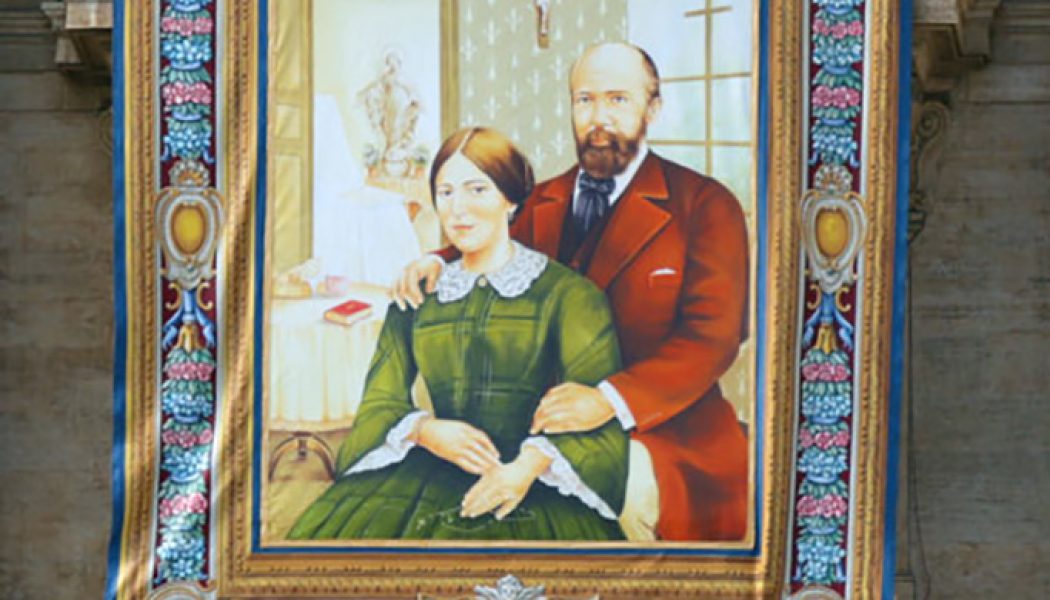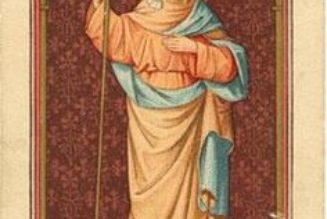
The canonization portrait of Louis and Zélie Martin, parents of St. Thérèse of Lisieux, in St. Peter’s Square, on Oct. 16, 2015. (Daniel Ibáñez/CNA)
The Holy Lives and Passions of Sts. Louis and Zélie Martin
The parents of St. Thérèse of Lisieux were the first husband and wife canonized as a couple.
They passed each other on a bridge one spring day — a distinguished, reserved, hardworking watchmaker who had tried and failed to become a monk and a lovely, intelligent, productive lacemaker who had been turned away by the Vincentian sisters. When St. Zélie first laid eyes on St. Louis she heard an interior voice, one that she had learned to trust, say, This is he whom I have prepared for you.
Their life together began on July 12, 1858 — a date remembered by the Church as the feast day of the first husband and wife canonized as a couple. While their married life was holy and admirable, God gave them the opportunity to enter into the suffering of the Cross at the end of each of their lives.
In their 19 happy years of marriage, Sts. Louis and Zélie ran a successful lacemaking business in Alençon, Louis having given up his trade to help his wife in hers. They had nine children, all of whom they baptized within days of their birth. When they lost four of their children, to childhood illnesses and the negligence of wet-nurses, since Zèlie was not able to breastfeed her children, they placed their hope in seeing them again in Heaven.
Louis and Zélie were very careful to raise their surviving children with virtuous habits, correcting their faults sternly, but also rewarding their good deeds with affectionate love. Zélie would pray about and examine the faults and strengths of each child and foster them into holiness and encouraged them to make little sacrifices every day to help them become less selfish.
Louis and Zélie sought a life of holiness together admits the increasing secularization of France and the anxieties of running a business and raising a family. The first accomplished this through a strong family union. A priest who knew them well said of them: “In their family life, the union was remarkable, both between the husband and the wife, and between the parents and the children.”
They sought holiness through the devotions and traditions of the Church. They never worked on Sunday, sought to do the works of mercy, and were very generous with their time and money towards the poor in the community. They always prayed for the souls of those who had died, and went out of their way to help dying people receive the Sacrament of Anointing of the Sick and Last Rites. They were very careful to follow the Church’s guidelines of fasting and abstinence, and even took on further voluntary mortifications.
The couple went every morning to 5:30 a.m. Mass, and to Holy Communion as often as the custom allowed, and were very faithful to making First Friday Communion. On Sundays they went to the Solemn High Mass and then back for Sunday Vespers. Louis was very devoted to making pilgrimages and participating in all-night vigils in reparation for the loss of the Catholic faith in France at his time.
Both husband and wife ended their years of devotion on earth, by bearing their own crosses of great suffering.
It was with great sorrow in December 1876, 18 years into their marriage, that they learned that the swelling in Zélie’s breast which had been causing concern for 11 years was very advanced cancer. She described her family’s reaction in a letter to her sister-in-law:
“I could not help from telling my family everything. I regret it now because there was a grief filled scene … everyone was crying, poor Léonie was sobbing. But I named so many people who’d lived ten or fifteen years like this, and I didn’t seem very upset, doing my work cheerfully as always, perhaps more so, that I calmed everyone down…
And yet, I am quite far from deluding myself, and I have trouble falling asleep at night when I think about the future. However, I’m resigning myself as best I can, but I was far from expecting such a test…
My husband is inconsolable. He’s given up the pleasure of fishing and put his lines up in the attic.” (A Call to a Deeper Love, CF 177, Dec. 17, 1876)
Despite the grim diagnosis, they never ceased to hope in God and accept his will. Zélie wrote to her sister-in-law:
“I wish that you would not worry too much about me, and that you will be resigned to the will of God. If He found me very useful here on earth He would certainly not permit me to have this illness, for I have prayed so hard not to be taken out of this world as long as I should be necessary to my children.” (Mother, p. 79)
Zélie’s main concern was for 13-year-old Léonie whose had struggled her whole life with behavior issues. Her transformation for better only began a few months after the cancer diagnosis. Zélie was confident that Marie who was 17 and 16-year-old Pauline could manage the home, and help to raise the littler girls, 8-year-old Céline and the future St. Thérèse who was 4. She saw them already seeking holiness.
In June 1877, Zélie took her three older children to Lourdes to pray for a cure. She wanted to live for the sake of her family. She went into the baths multiple times, had a miserable journey, and when she arrived back home, her illness took a turn for the worst. Zélie resigned herself to God’s will, placing her hope in the joys of Heaven. Her health diminished throughout July and August with such awful pain she could hardly find a comfortable position. After receiving Last Rites on Aug. 26, she departed for her heavenly home, surrounded by her family, on August 28, 1877.
In looking back at her mother’s life, Céline reflected, “In a word, always active, always devoted, constantly smiling, our mother never appeared to be doing anything extraordinary, but with remarkable simplicity and humility, she tirelessly spent herself for others, and lived always for the good of God.” (Mother, p. 99-100)
After the death of his wife, Louis lived on to raise his daughters, moving them to Lisieux to be near relatives. He found refuge in the joys of his family life, while remembering the hours he spent holding his dying, suffering wife in his arms.
“Everything which I have seen is grand, but it is still the beauty of the earth, and one’s heart remains unsatisfied until it beholds the joy of the infinite beauty that is God. We shall soon have the joy of being together again. It is the beauty of family life that comes nearest to Heaven.” (Rev. Fr. Stéphane-Joseph Piat, O.F.M., Story of a Family, p. 315)
As a widower, Louis spent much of his day in prayer and reading in his room in the attic that overlooked the garden which he tended himself. He kept up his habit of daily Mass and frequent Communion, and loved his afternoon walk with Thérèse. In the evening, he would read aloud and discuss from spiritual works other writings with his daughters.
One by one, he offered four of his daughters to the convent — Léonie entered and then left several times. A month after Thérèse entered the Carmelites in Lisieux in 1888, Louis, who had given up all whom he loved on earth, prayed at the Church of Notre Dame d’Alençon this prayer: “My God, it is too much! I am too happy; it is not possible to go to Heaven this way. I wish to suffer something for you, and I offer myself…” (Céline Martin, Father of the Little Flower, p. 84)
Two months after his prayer, he started suffering from paralyzing strokes. They weakened his mental state, and temporarily paralyzed his body. His dementia became so bad at one point one that he disappeared unexpectedly on trip for multiple days. He spent several years in a hospital run by religious sisters for the mentally ill, and once he lost the use of his legs, he was brought to live with his two daughters Léonie and Céline in a house near his brother-in-law.
On July 28, he suffered another heart attack, and received Last Rites and the Anointing of the Sick. On July 29, 1894, six years after the start of his suffering, Louis died a peaceful death.
In a letter to Léonie after his death Thérèse wrote:
“Papa’s death does no give me the impression of death, rather one of a true life. I find him again after six years absence; I feel him near me, looking at me, protecting me.” (Father, p. 119).
Céline joined her three other sisters in the Carmelites two months after her father joined her mother in Heaven, and Léonie (whose cause for beatification was introduced in 2015) successfully entered the Visitation convent in Caen in 1899.
Sts. Louis and Zélie Marin were beatified in 2008 by Pope Emeritus Benedict XVI and canonized in 2015 by Pope Francis. Their feast day is July 12.









